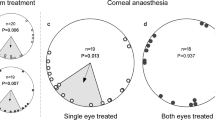Abstract
Bats famously orientate at night by echolocation1, but this works over only a short range, and little is known about how they navigate over longer distances2. Here we show that the homing behaviour of Eptesicus fuscus, known as the big brown bat, can be altered by artificially shifting the Earth's magnetic field, indicating that these bats rely on a magnetic compass to return to their home roost. This finding adds to the impressive array of sensory abilities possessed by this animal for navigation in the dark.
Similar content being viewed by others
Main
For some taxa, navigation behaviour can be readily investigated in the laboratory3. To study the wide-ranging navigation of bats, however, their flight path needs to be tracked in a natural setting. Limitations of the available technology make this a labour-intensive process, so bat navigation is relatively poorly understood compared with that of other animals2.
We used radio telemetry from a small aircraft4 to track big brown bats displaced 20 km north of their home roost (for methods, see supplementary information). A control group released from this site headed in a direction significantly towards home (see supplementary information) at 5 km from the release site (Fig. 1a).
a, Heading directions at 5 km after release 20 km north of the home roost (to south; black arrow). Arrowheads, directions for individual bats; arrows, mean direction for the group. Red, anticlockwise (ACW) rotation of magnetic field by 90° with respect to north; blue, clockwise (CW) rotation of magnetic field by 90°; green, controls (no rotation of magnetic field). Orientation was significantly southerly in controls (V test, 180°, U = 2.862, P = 0.0072); westerly in ACW bats (V test, 270°, U = 1.973, P = 0.023); and easterly in CW bats (V test, 90°, U = 2.66, P = 0.002). Headings differed significantly between the three groups (Watson–Williams 3-sample test: F = 16.808, P = 0.00033; pairwise: CW vs control, F = 23.774, P = 0.001; ACW vs control, F = 6.733, P = 0.032; ACW vs CW, F = 23.503, P = 0.001). b, c, Control (b) and experimental tracks (c) of bats, with different dotted and dashed lines for individual bats (n = 5 in each group). Colours indicate direction of rotation of magnetic field, as in a. R, release site; H, home.
To test whether bats use the Earth's magnetic field, we exposed two groups of bats to a rotated magnetic field, one 90° clockwise and one 90° anticlockwise with respect to magnetic north, for a period from 45 min before to 45 min after sunset. This also allowed us to test whether the Earth's magnetic field was being used in conjunction with other cues, such as the sunset or stars5 (see supplementary information).
The headings of the clockwise group were significantly oriented in an easterly direction (90°) at 5 km from the release site, whereas the anticlockwise group moved significantly in a westerly (270°) direction; the two groups showed a significant difference (Fig. 1a). These different initial orientations of the groups indicate that they may have been using a sunset-calibrated magnetic compass5,6.
Some experimental bats corrected and homed during the same night, despite being initially orientated away from home (Fig. 1b, c). Although such behaviour has previously been unknown in bats, homing pigeons can correct and return home after an initial deviation when clock-shifted7. We suggest that the deflected bats that nevertheless home during the same night recognize a mismatch between the direction they are flying and their navigational map.
Besides the application described here to measure bat navigation, radio telemetry has also been used to investigate migration in insects8. The possibility of transmitting such radio signals to low orbiting satellites should open up field studies on the orientation, navigation and migration of small, wide-ranging animals.
References
Simmons, J. A. et al. in Hearing by Bats (eds Popper, A. N. & Fay, R. R.) 146–190 (Springer, London, 1995).
Neuweiler, G. The Biology of Bats (Oxford University Press, New York, 2000).
Berthold, P. Bird Migration: A General Survey (Oxford University Press, Oxford, 2001).
Michener, M. C. & Walcott, C. J. Exp. Biol. 47, 99–131 (1967).
Cochran, W. W., Mouritsen, H. & Wikelski, M. Science 304, 405–408 (2004).
Muheim, R., Moore, F. R. & Phillips, J. B. J. Exp. Biol. 209, 2–17 (2006).
Bonadonna, F., Holland, R., Dall'Antonia, L., Guilford, T. & Benvenuti, S. J. Exp. Biol. 203, 207–212 (2000).
Wikelski, M. et al. Biol. Lett. 2, 325–329 (2006).
Author information
Authors and Affiliations
Corresponding author
Ethics declarations
Competing interests
The authors declare no competing financial interests.
Supplementary information
Supplementary information
(PDF 44 kb)
Rights and permissions
About this article
Cite this article
Holland, R., Thorup, K., Vonhof, M. et al. Bat orientation using Earth's magnetic field. Nature 444, 702 (2006). https://doi.org/10.1038/444702a
Received:
Accepted:
Published:
Issue Date:
DOI: https://doi.org/10.1038/444702a
This article is cited by
-
Sensitivity threshold of avian magnetic compass to oscillating magnetic field is species-specific
Behavioral Ecology and Sociobiology (2023)
-
The Relationship between the Magnetic Compass and Vision in Birds: In Search of Receptor Cells
Neuroscience and Behavioral Physiology (2023)
-
An artificial neural network explains how bats might use vision for navigation
Communications Biology (2022)
-
The discovery of the use of magnetic navigational information
Journal of Comparative Physiology A (2022)
-
Why is it so difficult to study magnetic compass orientation in murine rodents?
Journal of Comparative Physiology A (2022)
Comments
By submitting a comment you agree to abide by our Terms and Community Guidelines. If you find something abusive or that does not comply with our terms or guidelines please flag it as inappropriate.




